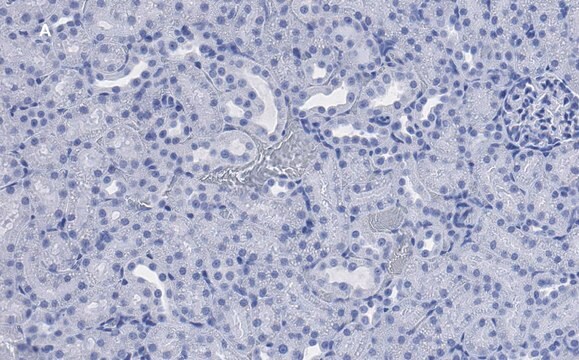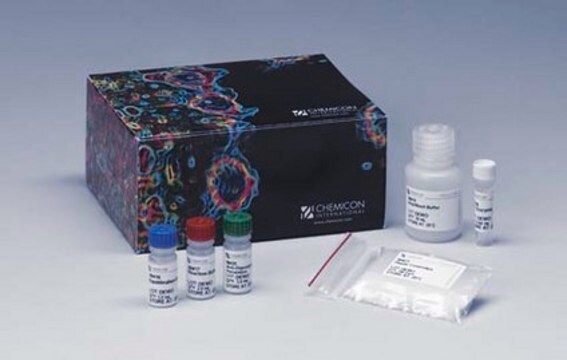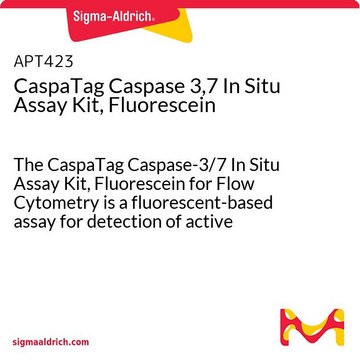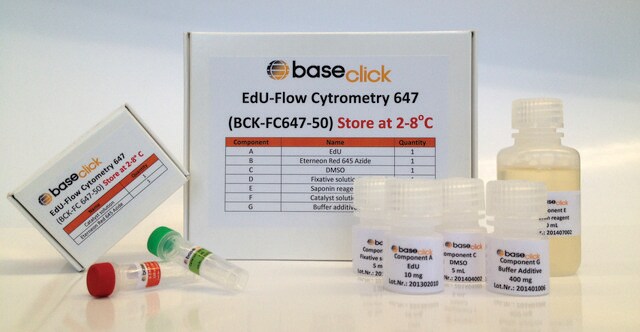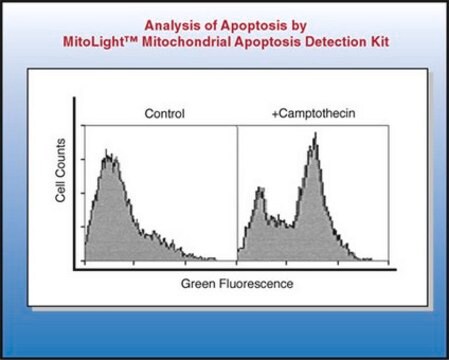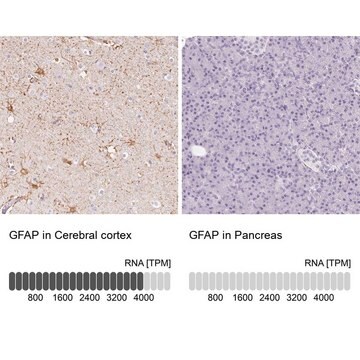APT400
CaspaTag Pan-Caspase In Situ Assay Kit, Fluorescein
The In Situ FLICA Pan-Caspase Detection Kit for flow cytometry is a fluorescent-based assay for detection of active caspases in cells undergoing apoptosis.
About This Item
Prodotti consigliati
Livello qualitativo
Reattività contro le specie (prevista in base all’omologia)
mammals
Produttore/marchio commerciale
CaspaTag
Chemicon®
tecniche
activity assay: suitable
flow cytometry: suitable
N° accesso NCBI
Metodo di rivelazione
fluorometric
Condizioni di spedizione
wet ice
Descrizione generale
Caspases have been identified in organisms ranging from C. elegans to humans. The mammalian caspases play distinct roles in apoptosis and inflammation. In apoptosis, caspases are responsible for proteolytic cleavages that lead to cell disassembly (effector caspases), and are involved in upstream regulatory events (initiator caspases). An active caspase consists of two large and two small subunits that form two heterodimers which associate in a tetramer (Walker et al. 1994; Wilson et al. 1994; Rotonda et al. 1996). In common with other proteases, caspases are synthesized as precursors that undergo proteolytic maturation, either autocatalytically or in a cascade by enzymes with similar specificity (Kumar 1999).
Caspase enzymes specifically recognize a 4 or 5 amino acid sequence on the target substrate which necessarily includes an aspartic acid residue. This residue is the target for cleavage, which occurs at the carbonyl end of the aspartic acid residue (Thornberry et al. 1997). Caspases can be detected via immunoprecipitation, immunoblotting techniques using caspase specific antibodies, or by employing fluorochrome substrates which become fluorescent upon cleavage by the caspase.
Test Principle:
CHEMICON′s In Situ Caspase Detection Kits use a novel approach to detect active caspases. The methodology is based on Fluorochrome Inhibitors of Caspases (FLICA). The inhibitors are cell permeable and non-cytotoxic. Once inside the cell, the inhibitor binds covalently to the active caspase (Ekert et al. 1999). This kit uses a carboxyfluorescein-labeled fluoromethyl ketone peptide inhibitor of caspase (FAM-VAD-FMK), which produces a green fluorescence. When added to a population of cells, the FAM-VAD-FMK probe enters each cell and covalently binds to a reactive cysteine residue that resides on the large subunit of the active caspase heterodimer, thereby inhibiting further enzymatic activity. The bound labeled reagent is retained within the cell, while any unbound reagent will diffuse out of the cell and is washed away. The green fluorescent signal is a direct measure of the amount of active caspase present in the cell at the time the reagent was added. Cells that contain the bound labeled reagent can be analyzed by 96-well plate-based fluorometry, fluorescence microscopy, or flow cytometry.
Application:
The CHEMICON In Situ FLICA Pan-Caspase Detection Kit is a fluorescent-based assay for detection of active caspases in cells undergoing apoptosis. The kit is for research use only. Not for use in diagnostic or therapeutic procedures.
Applicazioni
Apoptosis & Cancer
Componenti
10X Wash Buffer: 60 mL
Fixative (10% formaldehyde): 6 mL
Propidium Iodide: 1 mL at 250 μg/mL, ready-to-use
Hoechst Stain: 1 mL at 200 μg/mL, ready-to-use
Stoccaggio e stabilità
· Reconstituted FLICA Reagent (150X) should be frozen at -20ºC for up to 6 months, and may be thawed twice during this time. Aliquot into separate amber tubes if desired. Protect from light at all times.
· Store diluted (1X) wash buffer up to -20ºC for 2 weeks.
Note legali
Esclusione di responsabilità
Avvertenze
Danger
Indicazioni di pericolo
Classi di pericolo
Acute Tox. 3 Inhalation - Acute Tox. 4 Dermal - Acute Tox. 4 Oral - Carc. 1B - Eye Irrit. 2 - Muta. 2 - Skin Irrit. 2 - Skin Sens. 1 - STOT SE 2 - STOT SE 3
Organi bersaglio
Eyes,Central nervous system, Respiratory system
Codice della classe di stoccaggio
6.1C - Combustible acute toxic Cat.3 / toxic compounds or compounds which causing chronic effects
Certificati d'analisi (COA)
Cerca il Certificati d'analisi (COA) digitando il numero di lotto/batch corrispondente. I numeri di lotto o di batch sono stampati sull'etichetta dei prodotti dopo la parola ‘Lotto’ o ‘Batch’.
Possiedi già questo prodotto?
I documenti relativi ai prodotti acquistati recentemente sono disponibili nell’Archivio dei documenti.
Il team dei nostri ricercatori vanta grande esperienza in tutte le aree della ricerca quali Life Science, scienza dei materiali, sintesi chimica, cromatografia, discipline analitiche, ecc..
Contatta l'Assistenza Tecnica.
